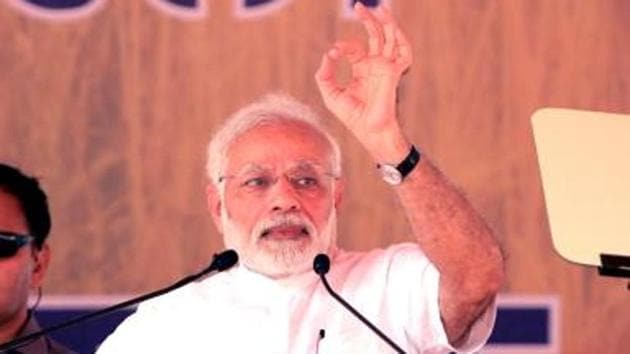A Modi-centric drive may backfire, writes Rajdeep Sardesai
In a democracy, such a campaign can put off the voter who instinctively dislikes excessive hubris
In the age of 24x7 news, Prime Minister Narendra Modi is the master of political theatre, his every move designed to maximise eyeballs. Which is why when he tweeted on Wednesday morning that he would address the nation across media platforms at noon, it sent news channels into a frenzy. While some speculated that Dawood Ibrahim or Masood Azhar may have been “eliminated”, my Mumbai stockbroker friends were worried that the Rs 2000 note was being demonetised.

Which is why the eventual announcement of India having successfully tested the Anti-Satellite (ASAT) missile was greeted mostly with a mix of relief, pride, and yes, controversy. Was it, after all, really the kind of dramatic moment that required a much-hyped televised prime ministerial address? Could the announcement have not been made by the Defence Research and Development Organisation’s team of scientists instead or, as Mr Modi’s critics suggest, has a certain pre-election desperation set in for the prime minister to seek political mileage at the cost of institutional integrity?
After all, Modi’s address to the nation comes within 48 hours of Rahul Gandhi doing his own little bit of political role-playing while announcing a minimum income guarantee scheme for the poor. Gandhi maybe attempting to galvanise a struggling opposition with his anti-poverty rhetoric but Modi has no reason to be as anxious. Every opinion poll shows the Modi-led NDA poised to return to power. Why, then, even as the model code of conduct has set in, did the prime minister feel the necessity to seek the arclights in the name of a strategic milestone? Was this the prime minister’s way of reclaiming the headlines which, at least for the previous two days, had been dominated by Gandhi’s promise of Nyuntam Aay Yojana (NYAY)?
After all, much like our soldiers, our scientists embody national pride. By almost co-opting a scientific achievement as his own, the prime minister is once again being accused of using ‘independent’ institutions to place his nationalist credentials before the voters, the fist pumping Bharat Mata ki Jai chant at the end of his speech reminiscent of an election campaign sign off.
And yet, this isn’t just about the optics of one speech. For the past five years, Modi’s imagemakers have relentlessly worked to cast their leader as a larger than life hero. From merchandise to movies, from social media to prime time television, Modi is being projected as the ultimate Superman who will conquer all before him. Then be it the Main Bhi Chowkidar (I, too, am a watchman) campaign or the Modi hai to Mumkin hai (Things are possible if Modi is there) tagline, the Bharatiya Janata Party’s (BJP) propaganda machine is designed to invest the prime minister with an aura of invincibility.
The cult of personality has often been a part of nearly every prime minister’s tool kit. The India is Indira and Indira is India slogan will haunt the Congress forever as will the fact that Jawaharlal Nehru received the Bharat Ratna while in office. The number of schemes named after members of the Nehru-Gandhi family are further evidence of political hagiography. When Atal Bihari Vajpayee was prime minister, his pictures would adorn vantage points along his pet Golden Quadrilateral project.
But Modi is setting new benchmarks. Then, be it petrol pumps billboards, Air India and railway tickets, or almost any government project, Modi’s image is always upfront. Certainly, no government in independent India has spent as much on advertising and marketing itself as the Modi government. An RTI (Right To Information) application last year revealed that the amount spent on propagating government schemes between mid-2014 and September 2018 was nearly Rs 5,000 crore. In the past six months, that amount has been scaled up, suggesting a near-total capture of the government machinery for political propaganda.
Omnipresent on the ground and across cyberspace, Modi has not only become the country’s foremost political leader but also dictated the national agenda. Which is perhaps why he was almost pushed by Gandhi’s pro-poor outreach to respond on TV with his own headline-grabbing moment. Which also suggests that the BJP’s relentless Modicentric campaign is a double-edged sword: while it converts a parliamentary battle into a presidential-like contest, it also can put off the voter who instinctively dislikes excessive hubris. Which is why the BJP’s political managers need to tread carefully when continuing to bombard the voter with their Modi Shining messaging. While Modi remains the BJP’s prime asset in its 2019 re-election bid, he also runs the risk of allowing real issues like jobs and agrarian incomes to be lost in an at times jarring myth making machine centred solely on the individual.
Post-script: While Modi has been glorified in the past five years, no leader has been perhaps as demonised as Jawaharlal Nehru in this period. And yet, ironically it was Nehru’s farsightedness that led to the setting up of the country’s space and defence research programme. Rather than politicise our science establishment by competitive credit-seeking , we should celebrate the continuum of a fine legacy that stretches back to India’s first prime minister and the many outstanding scientists this country has produced.
Rajdeep Sardesai is senior journalist and author
The views expressed are personal






